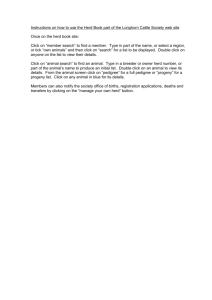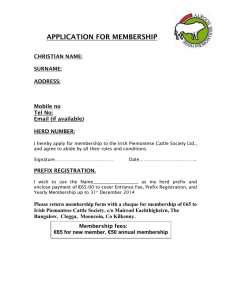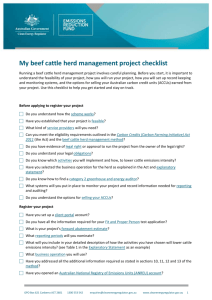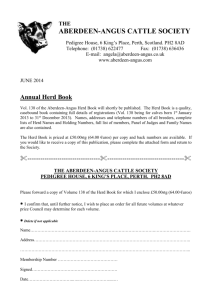Slajd 1
advertisement
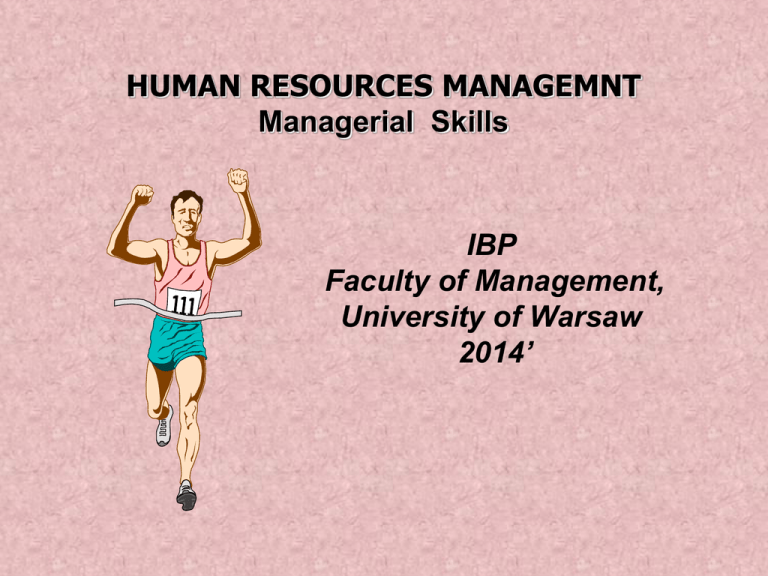
HUMAN RESOURCES MANAGEMNT Managerial Skills IBP Faculty of Management, University of Warsaw 2014’ JERZY JAGODZIŃSKI • Master studies – University in Łódź, Faculty of Sociology and Economics. M. A. in Foreign Trade. • Now - The editor in chief of Publishing Press at the School of Management- Warsaw University, as well as invited lecturer of European Integration, Problems of Globalization, Business Negotiation and Ethics. • Former director, editor-in chief in Polish Radio – Radio Polonia ( External Service) and in Polish Press Agency (PAP) – foreign desk. • married Tomasz Ochinowski Ph.D course coordinator • married, three children • Docent (Reader), Department of Organizational Sociology, School of Management, Warsaw University, Poland; • Member of the research team, which is focused on historiography and business history, Institute of History, Polish Academy of Science; • Civilian advisor to General Director of Prison Service in Poland; advisor of President of local government company • Trainer of the year 2006’ by Institute for International Research. Poland. My main trainers in managerial skills 2 Parts of HRM Basics of HRM and Managerial social skills training by Jerzy Jagodziński &Tomasz Ochinowski & his guests… Intercultural Communication in HRM by Halina Grzymała – Moszczyńska, Jagiellonian University Our rules Course Grading: 1. Classroom active participation (including one presentation during the course) will count for 50% of the final course grade. The presentation day: date to fix national groups; subject: „Brainwashing as HRM problem in my country” 2. Ongoing analysis of selected foreign companies operating in Poland in terms of HRM will count for 50%; Cross- cultural groups of 5 persons Cordially Welcome!!! Jerzy Jagodziński jjagodzinski@wz.uw.edu.pl room 310B in notice by mail Tomasz Ochinowski ochinto@ wz.uw.edu.pl my duty hours: Monday 4. 15 p.m. – 5.45 p.m. 3 Szturmowa Street, room B514. To sum up… from the beginning… by Daniel J. Boorstin, The Americans. The Democratic Experience and http://www.pbs.org/weta/thewest/people/d_h/goodnight.htm „There's gold from the grass roots down, but there's more gold from the grass roots up” California Joe, a guide in the gold-rich Dakotas in the 1870's. „Legend has it that… sometime toward the end of the Civil War a heavyladen government ox train traveling through the northern plains of eastern Wyoming was caught a snowstorm and had to be abandoned. The driver returned the next spring to see what had become of his cargo. Instead of the skeletons he had expected to find, he saw his oxen living, fat and healthy.” Charles Goodnight the Secret of Success 1866 (68) - he and Oliver Loving made a new trail from Belknap, Texas, to Fort Sumner, New Mexico, which became known as the Goodnight-Loving Trail. They delivered 2000 head of cattle They had made more than $12,000 Goodnight multiplied the quote later 1836-1929 Charles Goodnight (some details) • He had lived in Texas since 1845 • 1866 (68) - he agreed with his partner to deliver $ 40 000 worth of Texas Longhorns’ big herd (2000 head of cattle) across 800 miles, from Texas to Wyoming [ oxenn bought for $3 or $4 a head in Texas, sold for $35 or $ 40 up North] • Goodnight was trailing cattle north by the thousands and achieved fame and fortune. After about 10 -20 years… barbed wire RANCHES • In 1877 he with John Adair build JA Ranch (soon counted one hundred thousand cattle and million acres) • He founded the first cattlemen’s association to fight cattle thieves in the region; developed new equipment for the drive ant the ranch; improved cattle breeds by crossing • After the death of his first wife, to whom he had been married for 55 years, he remarried at the age of 91 and had his first child ! Secrets of Goodnight’s „Success ? „(...) The cattle, of course, moved on their own legs, but the vehicle that carried them was the organized drive” clear rules „Before starting on a trial drive Goodnight made it a rule ‘to draw up an article of agreement, setting forth what each man was to do. The main clause stipulated that if one shot another he was to be tried by the outfit and hanged on the spot, if found guilty’.” [ „boundary”] „The successful drive had to be sober and orderly”… so… liquor, gambling, and even swearing were prohibited on the trial [„zero tolerance”] virtual communication „Communication on the trial (…) was by hand signals, mostly borrowed from the Plains Indians” structure and dynamic „The cowboy crew gave shape to the mile-long herd, kept the cattle from bunching up into a dense, unwieldy mass or from stringing out to a thin, discontinuous thread. At the front were two of the most experienced men (called „pointers”), who navigated the herd, following the course set by the foreman. Bringing up the rear were three study cowboys whose job it was ‘to look out for the weaker cattle(…) – ‘keep out the corners. The rest of the crew were stationed along the sides(…)” [flat structure] „The men were rotated from front to rear and back toward the front (the nearer the point, the lighter the work) to divide the burden on the men and the horses” [rotation] risk strategy procedures for stampede logistic • „To feed the men there had to be a chuck wagon, carrying food and utensils, which the cook would drive fast ahead to the next camping place so that food could be ready when the herd arrived” [catering] • The horses (called the „remuda”) which were brought along as spares to provide remounts were in care of a wrangler who kept them moving along together, just in front of the herd [weak points support by outsourcing] organizational culture „At night, guards making their rounds would sing and whistle (the veteran cowman Andy Adams explained) „so that the sleeping herd may know that a friend and not an enemy is keeping vigil over their dreams”. As wellserenaded herd would be less apt to stampede. Cowboy „hymns” they were called, because their tunes were compounded from childhood memories of church services. But their words told the exploits of famous horse races, addressed the cattle with endearment or blaspheming, repeated advertising slogans from coffee cans, or simply sprinkled profanity between nonsense syllables” special responsibility of top managers „(...)The foremen and owner (…) were responsible for the lives of their men, not only against Indians so far as possible, but against each other in all cases.” Fundamentals of HRM Main functions of Top Managers: - staffing (getting people – strategic HR planning, recruiting, selection) - training and development (preparing people – employee training and development, career development, organization development) - motivation (stimulating people – motivation theories and job design, performance appraisals, rewards and compensation, employee benefits ) - maintenance functions (keeping people – safety and health, communications, employee relations) GLOBAL VILLAGE ENVIRONMENT by D. Decenzo Modern manager must be prepared to deal with constantly changing world, which means understanding implications of: - globalization - technology changes - work – force diversity - changing skills requirement - continuous improvement initiatives - contingent work force - decentralized work sites - employee involvement GLOBAL VILLAGE ENVIRONMENT by D. Decenzo Modern manager must be prepared to deal with constantly changing world, which means understanding implications of: - globalization - technology changes - work – force diversity - changing skills requirement - continuous improvement initiatives - contingent work force - decentralized work sites - employee involvement GLOBAL VILLAGE ENVIRONMENT The crucial question is: HOW THESE CHANGES ARE AFFECTING MANAGERIAL GOALS AND PRACTICES ? GLOBAL VILLAGE – MOBILITY! Multicultural / multinational / multilingual environment RACE POLITICS RELIGION LAW CUSTOMS & HABITS Flexibility & Availability – highly important for managers working in multicultural environment Managers must develop mechanisms that will help multicultural individuals work together & build teams WORK – FORCE DIVERSITY Nowadays • challenge for employees is to make their organizations more accommodating to diverse groups of people by addressing different life styles, family needs and work styles. • employers try to recognize and celebrate of differences - these are finding their organizations more profitable and effective Thank you, See you…


